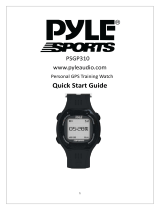
Navigating to a Point of Interest............................................... 34
Points of Interest.................................................................. 34
Creating and Following a Course on Your Device.................... 34
Creating a Round-Trip Course..................................................34
Viewing or Editing Course Details............................................ 34
Using ClimbPro......................................................................... 34
Marking and Starting Navigation to a Man Overboard
Location.................................................................................... 34
Navigating with Sight 'N Go...................................................... 35
Navigating to Your Starting Point During an Activity................ 35
Viewing Route Directions..................................................... 35
Navigating to the Starting Point of a Saved Activity................. 35
Stopping Navigation................................................................. 35
Map........................................................................................... 35
Viewing the Map.................................................................. 35
Saving or Navigating to a Location on the Map................... 35
Navigating with the Around Me Feature.............................. 36
Changing the Map Theme................................................... 36
Compass...................................................................................36
Setting the Compass Heading............................................. 36
Altimeter and Barometer........................................................... 36
History........................................................................... 36
Using History............................................................................ 36
Multisport History................................................................. 36
Viewing Your Time in Each Heart Rate Zone...................... 36
Viewing Data Totals.................................................................. 36
Using the Odometer..................................................................37
Deleting History........................................................................ 37
Customizing Your Device............................................ 37
Activities and App Settings....................................................... 37
Customizing the Data Screens............................................ 38
Adding a Map to an Activity................................................. 38
Alerts.................................................................................... 38
Setting an Alert................................................................38
Activity Map Settings............................................................38
Routing Settings...................................................................39
Auto Lap...............................................................................39
Marking Laps by Distance............................................... 39
Enabling Auto Pause........................................................... 39
Enabling Auto Climb............................................................ 39
3D Speed and Distance....................................................... 39
Turning On and Off the Lap Key.......................................... 39
Using Auto Scroll................................................................. 39
Changing the GPS Setting................................................... 40
GPS and Other Satellite Systems................................... 40
UltraTrac......................................................................... 40
Power Save Timeout Settings..............................................40
Changing the Order of an Activity in the Apps List................... 40
Widgets..................................................................................... 40
Customizing the Widget Loop.............................................. 41
inReach Remote.................................................................. 41
Using the inReach Remote............................................. 41
VIRB Remote....................................................................... 41
Controlling a VIRB Action Camera.................................. 41
Controlling a VIRB Action Camera During an Activity..... 41
Using the Stress Level Widget............................................. 42
Customizing the My Day Widget.......................................... 42
Customizing the Controls Menu................................................42
Watch Face Settings.................................................................42
Customizing the Watch Face............................................... 42
Sensors Settings.......................................................................42
Compass Settings................................................................ 42
Calibrating the Compass Manually................................. 42
Setting the North Reference............................................42
Altimeter Settings................................................................. 43
Calibrating the Barometric Altimeter............................... 43
Barometer Settings
.............................................................. 43
Calibrating the Barometer............................................... 43
Xero Laser Location Settings............................................... 43
Map Settings............................................................................. 43
Map Themes........................................................................ 43
Marine Map Settings............................................................ 43
Showing and Hiding Map Data............................................ 44
Navigation Settings................................................................... 44
Customizing Map Features.................................................. 44
Setting Up a Heading Bug................................................... 44
Setting Navigation Alerts......................................................44
Power Manager Settings.......................................................... 44
Customizing the Battery Saver Feature............................... 44
Customizing Power Modes.................................................. 44
Restoring a Power Mode..................................................... 44
System Settings........................................................................ 44
Time Settings....................................................................... 45
Setting Time Alerts.......................................................... 45
Syncing the Time............................................................ 45
Changing the Backlight Settings.......................................... 45
Customizing the Hot Keys....................................................45
Changing the Units of Measure........................................... 45
Viewing Device Information...................................................... 45
Viewing E-label Regulatory and Compliance Information.... 45
Wireless Sensors......................................................... 45
Pairing Your Wireless Sensors................................................. 46
Extended Display Mode............................................................ 46
Using an Optional Bike Speed or Cadence Sensor.................. 46
Training with Power Meters...................................................... 46
Using Electronic Shifters...........................................................46
Situational Awareness.............................................................. 46
Foot Pod................................................................................... 46
Improving Foot Pod Calibration........................................... 46
Calibrating Your Foot Pod Manually.................................... 46
Setting Foot Pod Speed and Distance................................. 46
tempe™.................................................................................... 46
Club Sensors............................................................................ 47
Device Information....................................................... 47
Descent Mk2 Specifications......................................................47
Battery Information...............................................................47
Data Management.................................................................... 47
Deleting Files....................................................................... 47
Device Maintenance..................................................... 47
Device Care.............................................................................. 47
Cleaning the Device............................................................. 47
Changing the QuickFit® Bands................................................ 47
Extra Long Diving Band............................................................ 48
Troubleshooting........................................................... 48
My device is in the wrong language......................................... 48
Is my smartphone compatible with my device?........................ 48
My phone will not connect to the device................................... 48
Can I use my Bluetooth sensor with my watch?....................... 48
My headphones will not connect to the device......................... 48
My music cuts out or my headphones do not stay connected.. 48
Restarting Your Device............................................................. 48
Resetting All Default Settings................................................... 48
Diving........................................................................................ 48
Resetting Your Tissue Load.................................................48
Resetting the Surface Pressure........................................... 48
Acquiring Satellite Signals........................................................ 49
Improving GPS Satellite Reception......................................49
The temperature reading is not accurate.................................. 49
Maximizing the Battery Life.......................................................49
Activity Tracking........................................................................49
My daily step count does not appear................................... 49
Table of Contents iii





















